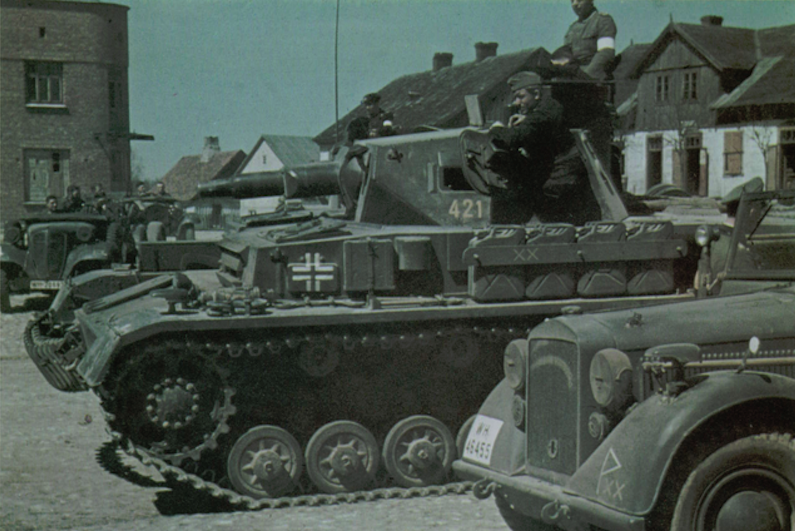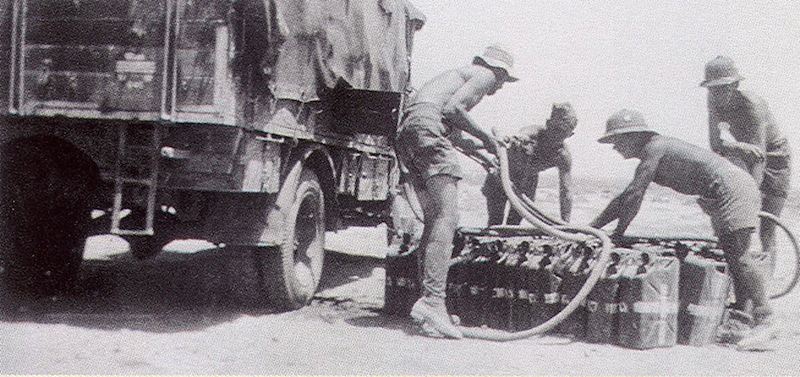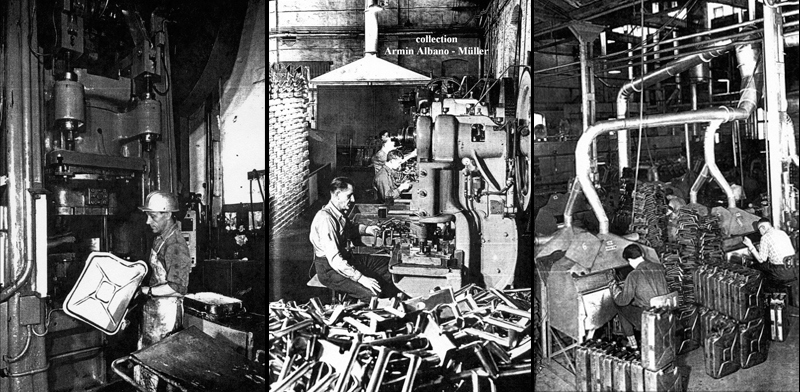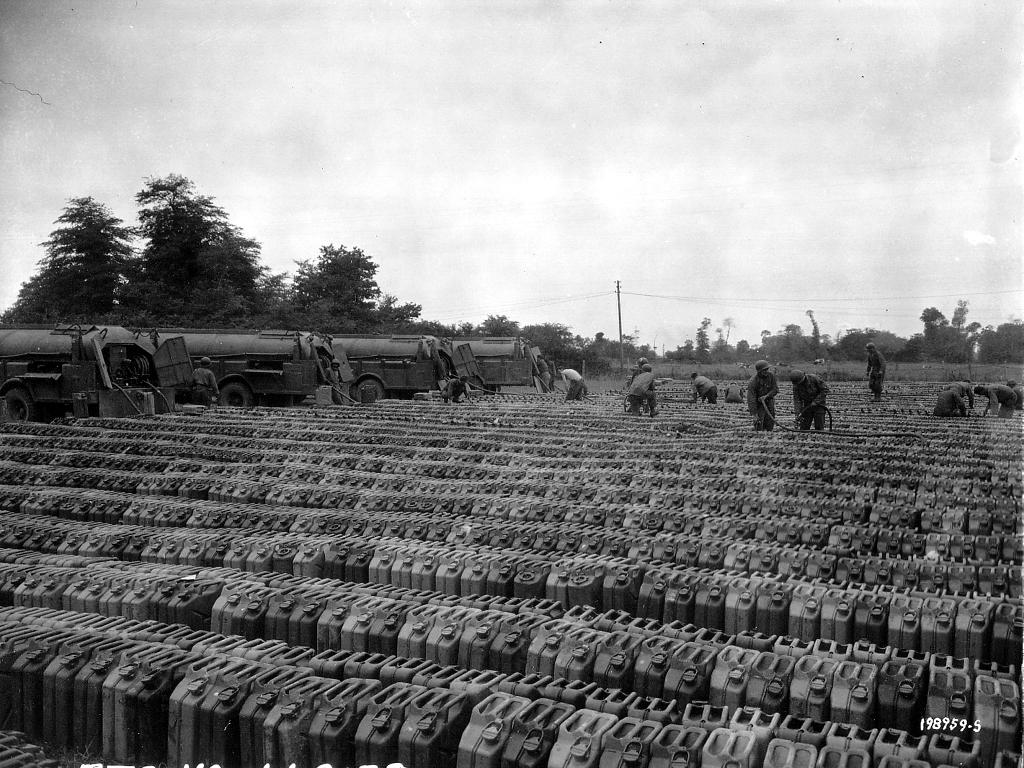Although it might seem difficult to accept for the victorious allies in the Second World War, the germans were far ahead of them in terms of industrial design and warfare technology. We could talk for hours about the superiority of the Panther Tank, or the evil futuristic destruction power of the un-piloted V1 & latter V2, an early pulse-jet-powered predecessor of the cruise missile. But its not about these complex wonders that we want to talk about today, but rather of an utter simpler design we all own, or at least have operated in our lives. This is the Wehrmachtkanister or Jerrycan, as it is now known today, “Jerry” being Allied the slang for German.

Armies need fuel almost more than water, so in Nov. 1936 the German Army launched an invitation to tender for a new model of container to replace the old cans and equip all their motorized units. The firm Müller of Schwelm under the direction of the chief engineer Vinzenz Grünvogel developed a revolutionary new design that is still as good today as it was almost one century ago. A modern design masterpiece which we are very proud to use as only fuel reservoir in our rebellious Ducati Petardo, an adventure that made us need to know more about the cool Jerrycan.

With rectangular form and curved edges, it was constructed from two pressed steel plates, needing to be assembled by just one single weld in the central gutter, or “Equator”, and an X-shaped indentation on each side which ensured its shock protection, never leaked, and had a capacity of twenty liters with a weight of only four kilos. Maybe the most interesting part is the handle with three bars. And you may think why three?



In contrast the Allies were carrying fuel in the so called “Flimsy”, which was a flat sided, unergonomic, pressed steel container, in which all flat sides needed to be individually welded together at the edges. You needed a wrench to attach and remove the cap, a funnel to fill the container and a spout to empty it. The containers held four Imperial gallons… and tended to leak at the corners, where the welds would fail, and there why the containers became colloquially known as “flimsies.”


14 Responses
Anyways this is just our opinion and of course it might be wrong
Hay mucha leyenda sobre la superioridad Alemana, la cuestión es que aunque sobre el papel, tanto los Tigers como los Panthers eran muy superiores, la verdad es que se averiaban mucho, de hecho se averiaban muchísimo y por ejemplo, aunque técnicamente eran inferiores, hubo M4 Sherman que desembarcaron en Normandía o en Italia y llegaron a Alemania y aunque el cañón original de 75 mm se quedaba muy, muy corto, el Firefly británico con cañón de 17 libras acojonaba hasta a los Tigres, si no que que le pregunten a Michael Wittmann. En el tema de la aviación, aunque los Messersmitch BF-109 o los Focke-Wulf BF-190 eran grandes aviones y diseñaron los primeros cazas a reacción, los primeros no tenían nada que hacer contra los P51 Mustang o los Spitfire y los reactores tenían menos autonomía que un mechero, los pilotos aliados sólo tenían que esperar a que se quedarán sin combustible para derribarlos, amén de lo peligroso que era en combustible para los pilotos, que literalmente los podía disolver.
Así y todo no se puede poner en duda los magníficos ingenieros que había en el bando alemán, tanto las carreras espaciales americana y soviética no se habrían podido llevar a cabo sin ellos.
Un abrazo.
Gracias por tal clase magistral!
Abrazo!!!
It is nice to hear about the good design and engineering of the jerry can. I don’t care about who won or lost the war or the politics of discussing that stuff, but it is fun to see how things were invented, made, used, modified and still continue to be useful.
The kicker was, the Germans ran out of fuel in the end. Great gas can though. Love articles like this, keep up the outstanding posts!
Love the technical article. Never thought that famous jerrycans came from Germany!!
Gracias amigoo…
Germans didn’t just have superior technology during WW2, but are still up there with the very best today.
Give credit where it’s due
The jerrycan is a clever piece of design. Even so, I would say that the bigger accomplishments in WW2 were on the Allied side. And the best technology. I’m still impressed by the US war effort. They built the biggest and best naval combat force in a couple of years while fighting. The State invested heavily, all they had and all the money they could get from the public, and built a huge industry that transformed the US, a country that before the war had a GDP equal more or less equal to Germany’s, in an indutrial giant. After the war, President Truman had his Office of Statistics calculate how much a worker should make to live a middle class life and afford consumer goods and forced big companies that had profited enormously from those investments to rase salaries accordingly.That’s how the US became a superpower. So much for free market, deregulation, etc.
FWIK German tanks only were better in battle because their optical aiming systems were superior to British or Russians’. They were made by Zeiss.
Bottom line is that even in present times most technological advances come from the military industry. I guess that’s because it’s the only sector with guaranteed continous public investment in I+D
i liked this about THE WEHRMACHTKANISTER AKA: THE JERRYCAN, the Germans fabs Quality stuff .. good article…
[…] Prepandmore El Solitariomc Overland Expo […]
El Loco Solaritario says: “We could talk for hours about the superiority of the Panther Tank, or the evil futuristic destruction power of the un-piloted V1 & latter V2, an early pulse-jet-powered predecessor of the cruise missile”…
History and reality says “We could also talk for hours about the superiority of the M1 Garand, the jeep, the 2 1/2-ton 6×6 truck, the Spitfire, the P51 Mustang, the C-47, British radars, American mass production, the Pratt&Whitney R-2800, the U.S. fleet submarine, the B-29, the Essex-class aircraft carrier, Fletcher-class destroyers, Baltimore class heavy cruisers, western democracy vs. fascism, Roosevelt vs. Hitler, the Marshall Plan…oh, and a little piece of mathematics and engineering called the atomic bomb.” You bozos need to read more and pose less.
whatever loser